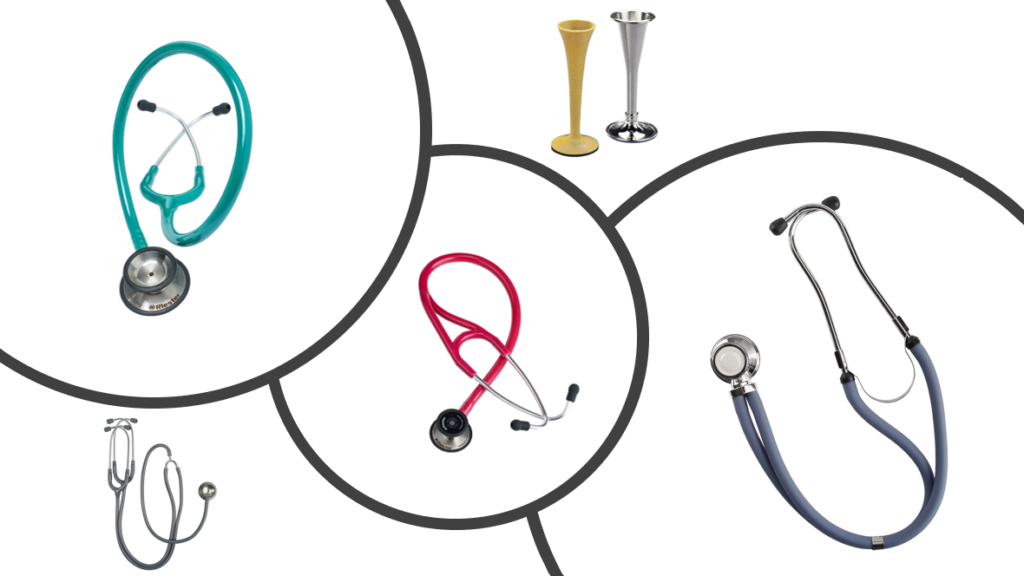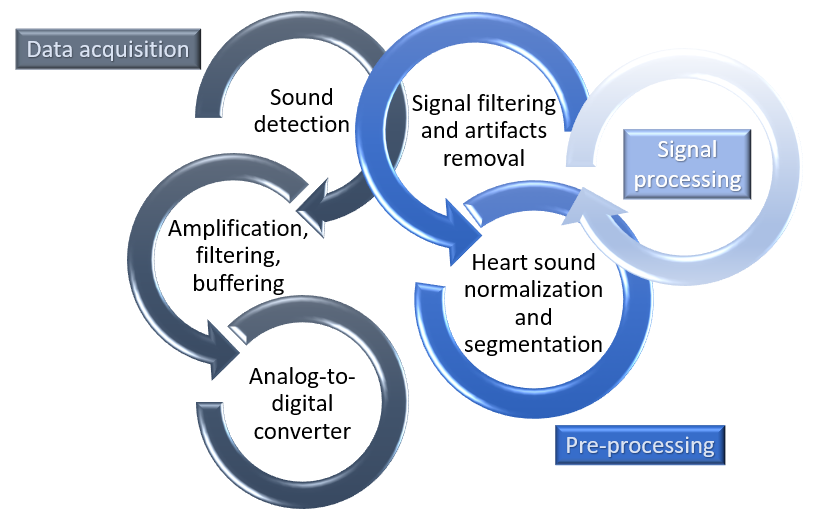stethoscopes LEARNING MODULE
The human auditory system is not automatically attuned to the intensity (volume) and to the frequency (pitch) of the sounds emitted by the body. The intensity and frequency of cardiac sounds for example is lower than what the ear is accustomed to hearing; heart sounds must therefore be made louder to be heard. The stethoscope is able to amplify sounds.

Heart sounds
A stethoscope can be used to listen to the sounds the heart make as it contracts and relaxes. By listening on various locations within the area of the heart, a doctor can identify abnormalities such as murmurs, clicks or any irregular patterns. For a healthy adult, two sounds are expected to a heartbeat: a "lub" and a "dub", forming the familiar "lub-dub" sequence.

Abdominal sounds
Because the intestines are hollow, the grumbling/growling sounds they produce throughout the digestion process are easy to hear when placing the stethoscope on the abdomen. The abdomen is divided in four sections for auscultation with the patient's bellybutton as reference. The doctor will listen to all four sections: anything else than growling or grumbling sounds in all four sections will require further attention.

Lung sounds
Breathing sounds should be consistent across all four areas of the lungs without cracking or wheezing sounds indicative of obstruction or breathing problem. The doctor places the stethoscope on the right lung first, starts at the bottom right and listens to all four quadrants in a clockwise fashion while the patient is leaning forward before moving to the left lung.

Blood pressure measurement
Blood pressure can be measured using an aneroid sphygmomanometer and a stethoscope. The bell of the stethoscope is pressed over the brachial artery just below the cuff’s edge to listen to the Korotkoff sounds.
Acoustic stethoscope
The standard stethoscope is an acoustic listening device used to listen to body sounds amplified by its design, more commonly those emitted by the lungs, the heart, the abdomen and the intestines. There are two sides to a standard stethoscope: a bell and a diaphragm. When the diaphragm is put on the chest, the sounds of the body cause the diaphragm to vibrate, generating sound waves that move up the tube to the user’s ears. When the bell is put on the chest, it is the skin that generates the vibrations from which sound waves travel up the tube. Issues with blood pressure, blood flow, respiration or foetus development, for example, can be detected by a trained user because of the distinctively different sounds they cause.
Anatomy of an acoustic stethoscope

1. Tubing
A. Chest piece
2. Stem
3. Non-chill rim
4. Bell for low frequencies
5. Membrane (diaphragm) for high frequencies
B: Headset
6. Eartip
7. Eartube
The headset typically comprises of two eartubes mounted on tension springs with one eartip attached to each eartube. The eartube are bendable so that the eartips can be angled to perfectly match the ear canal of the user. The two eartubes can also be pushed in or out to ensure the fit is neither too loose or too tight.
The eartips are made of a soft rubber or silicone with a hole in the centre to let the sound travel and are attached to the ribbed end of the eartubes. They are available in different sizes to provide the user with a snug yet comfortable fit and create an acoustic seal. This ensures that the sound that reaches the ear is as clear and pure as possible.
The eartubes are made of metal and designed at an angle allowing the best fit into the user’s ear canals. They connect the stethoscope tubing to the eartips, isolating the sounds and directing them into the left and right sides.
Also known as the head and responsible for conducting sound. Made up of the diaphragm and/or bell, and the stem. It is usually placed directly on the skin but technological advancements have made it possible to listen through certain materials (clothing, bandages, blankets, animal fur, etc.) with certain stethoscopes.
The chestpiece can vary between different models. It may be one-sided (diaphragm only) or two-sided (bell on one side, diaphragm on the other side). Some one-sided chestpieces have tunable or pressure-sensitive diaphragms that can act as both a bell and a diaphragm. Having both makes the chestpiece suitable for a wider range of patients as the bell side is best for paediatric or thin patients and the membrane side, best for adult patients.
Chestpieces are usually made of metal, but there are now also acrylic head stethoscopes which are good for blocking out ambient noise.
The stem is the metal tube that connects the tubing to the chestpiece.
The bell is suitable to hear the lower frequencies of sound and the diaphragm is suitable for the higher frequencies. A non-chill rim attached fitted on the outer edge of the diaphragm improves adaptation to the skin for better sound pick-up and enhances patient comfort.
Soft tube made from PVC that connects to the stem and the eartubes. Usually 100% latex-free. It is responsible for relaying the sounds picked up by the chestpiece to the eartubes so that they can be heard. Tubing exists as a single tube or dual lumen tube (split in half on the inside). By having two sound channels inside one outer tube, left and right paths are created, making for a more accurate hearing.

How to choose?
Because the choice of stethoscope depends on different factors for everyone, there isn’t one single best type of stethoscope. If it is to be used often in a loud environment, good noise reduction is important. If it is to be used in neonatal care, a stethoscope specifically designed for babies is ideal. When the financial means are available, an electronic (also called digital) stethoscope should be seriously considered.
Electronic stethoscope
Low sound volume is a frequent issue with the traditional acoustic stethoscope making it difficult for a clinician to perform an accurate auscultation. Electronic stethoscopes convert acoustic sound waves from the chestpiece into electronic signals that can be amplified and offer significant improvements.
What makes the electronic stethoscope so much more powerful than the acoustic stethoscope?
Sounds can be heard better
Sounds can be amplified to a whole new level
Sounds can be recorded, stored and transmitted
Less noise when listening to a specific organ
The electronic stethoscope has been around for decades and even used on NASA Space Shuttle missions to monitor the astronauts’ health but its initially bulky format and high price tag kept it from receiving the clinical attention it deserved. With its now modern, compact design, ease of use and lower price tag, it is sparking more interest. The electronic stethoscope is an extremely powerful scope that works on the same principle as simple acoustic stethoscopes but can electronically amplify the sounds. It provides several additional or improved features such as visual as well as audio output, noise reduction and dynamic frequency filtering to clarify the sound and better isolate the different audio frequencies at various body sites. Because the sounds are digitized, they can be encoded, stored or forwarded and decoded at the other end. Two doctors in two separate locations can listen to the auscultation simultaneously or a patient can have a remote consultation with their doctor (real-time telemedicine). The auscultation file can also be saved and consulted at a different time (store-and-forward telemedicine).
Modern electronic stethoscopes no longer require transmitter/receiver boxes to encode and decode the audio signals. They are available as standalone devices with either mic port, USB port or Bluetooth connectivity to answer various needs.
Electronic stethoscopes vary greatly in the technologies that they use. Here are the most important considerations when purchasing one:
- Sound detection can be via microphone, piezo-electric sensor or capacitive-type sensor.
- Noise cancelling is based on algorithms: even more variability, often proprietary.
- Frequency filters vary with system design.
- Connectivity can be wired (USB port, 3.5mm mic jack) or wireless (Bluetooth). Bluetooth and USB connectivity imply that the key audio processing elements take place inside the stethoscope rather than through the audio circuitry of the connected computer (bad audio circuitry of a computer would affect the sound quality of a mic port connected stethoscope).
- Others: depending on the needs, different electronic stethoscopes will offer different levels of amplification (may be particularly helpful with obese patients or large animals), different OS compatibility (Windows, iOS, Android…), AI decision support capability, record-and-forward (live or asynchronously) capability for telemedicine use, software integration to help with diagnosis and filter the sounds, EMR integration for storage, etc.
- Microphone:
Placing an electret microphone in the chestpiece is the simplest way to detect sounds. The microphone is placed behind the stethoscope diaphragm. As sound pressures are created by the stethoscope diaphragm, they get picked up by the microphone which converts them to electrical signals. However because the microphone itself also has a diaphragm, sound pressures end up having to travel through two diaphragms plus the air inside the stethoscope, making for an inefficient acoustic energy transfer and excess ambient noise pickup.
- Piezo-electric sensor:
Piezo-electric sensors produce electrical energy by deformation. When the sensor is coupled to the stethoscope diaphragm and gets deformed by the diaphragm motion, an electrical signal is generated. Piezo-eletric sensors are the most sensitive strain gauge technologies offering stable and repeatable accurate electrical output. The downside of the piezo-electric sensor is that the sound may have a slightly different tone and level of distortion when compared to the acoustic stethoscope due to the conversion mechanism. The quality of the inner design and the filtering/noise cancelling capabilities are therefore important.
Most commercially available electronic stethoscopes incl. the market leading brands use a piezo-electric sensor for sound detection.
- Capacitive-type sensor:
The capacitive-type sensor is based on the Micro-electro-mechanical system (MEMS). A change in the sensor’s nominal capacitance value indicates that an acoustic pressure was detected. This type of sensor is used by Thinklabs®.
Electronic stethoscope in telemedicine
Using the eMurmur digital auscultation platform as a reference for the telemedicine use of an eStethoscope, we find three primary modes of virtual auscultation:

Synchronous auscultation - 1 patient having consultation with their provider remotely
eMurmur Connect includes a patient-facing interface that connects providers with patients at home. The patient at home self-navigates the stethoscope as per provider instructions. Heart and lung sounds are live streamed to the provider, who hears the high fidelity sounds via the web portal.

Synchronous auscultation - 1 patient with their provider + another provider joining remotely
The primary care provider is with the patient and live streams auscultation sounds to a consulting provider, who hears and sees the sounds via eMurmur’s browser-based web portal.

Asynchronous auscultation - 1 patient with their provider + another provider consulting remotely at a later time
The primary care provider is with the patient, stores the auscultation data in the secure eMurmur cloud, and requests remote consultation. The consulting expert reviews the case and provides feedback via the web portal.

eMurmur Connect
With eMurmur Connect, providers can perform heart and pulmonary auscultation remotely, whether it is in real time or not, and safely access their auscultation data via the web-based platform. Patients’ heart and lung sounds can be transmitted in real time at lossless quality. A variety of custom designed filter options enable a stethoscope-like hearing experience.
eMurmur ID
Artifical intelligence is an extremely powerful to add to a telemedicine solution. eMurmur ID is an FDA and CE approved mobile and cloud AI solution which operates in conjunction with a 3rd party electronic stethoscope. It uses advanced machine learning to identify and classify pathologic and innocent heart murmurs, the absence of a heart murmur, and S1, S2 heart sounds. The end-to-end solution is comprised of AI-based analytics, a mobile app, and a web portal (all HIPAA compliant). It supports the workflows of healthcare providers performing cardiac auscultation and has multiple applications including primary and specialty care, and corporate health.
Leng, S., Tan, R.S., Chai, K.T.C. et al. The electronic stethoscope. BioMed Eng OnLine 14, 66 (2015). https://doi.org/10.1186/s12938-015-0056-y

